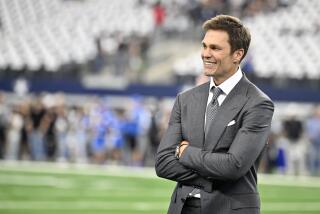Davis Claims He Is a Victim of Fraud
- Share via
SACRAMENTO — Even though he increased his ownership stake in the Raiders from 30% to 38% since moving the team to Oakland in 1995, Al Davis testified he “saw a franchise [going] up in smoke” because of alleged false promises of sellouts at the Oakland Coliseum.
“I considered it a fraud,” he said Tuesday during his third day of testimony in his $1-billion lawsuit against Oakland officials. “They conned me. They got me.”
Davis said the Raiders would be far more valuable had he moved them from Los Angeles to Baltimore -- a city he claims was wooing him -- instead of back to Oakland. He also said he strongly considered a proposal for a new stadium at Hollywood Park but the final choice came down to Oakland or Baltimore.
Claiming the Raiders have been “scarred” by lawsuits and a lack of sellouts, Davis estimated his team will be worth between $400 million and $450 million by 2010. That’s about half as much as he said the franchise would be worth had there been sellouts from the start. And if the team had moved to Baltimore -- where the Cleveland Browns wound up moving -- it would be worth in the neighborhood of $1 billion by 2010, he said.
Davis is the majority shareholder in the eight-member partnership that owns the Raiders. Oakland attorney Jim Brosnahan, who began his cross-examination Tuesday afternoon, questioned why Davis would want to increase his stake in the team if the lack of sellouts was so financially crippling.
“If you go from 30% to 38% it’s because you think the future looks good and you should put that amount of interest in there,” Brosnahan said outside of court. “So it seems to me that’s a better testimonial to what Mr. Davis thinks the future holds than some of the experts who have been kind of hanging crepe about it’s all bad.”
Countered attorney Roger Dreyer, who represents the Raiders: “There’s nothing about [Davis] saying it’s a bad investment. It’s a tremendous investment. There’s nothing like the NFL.... But because you’re involved in a great business, that doesn’t mean, ‘OK, you can take us down.’ ”
Davis said he moved the team in large part because he was promised the Coliseum would be sold out throughout the 1995 season, and, by Thanksgiving of that year, all the general-admission seats, club seats and luxury suites would be sold for the 1996 season.
The Raiders made the move believing their local revenues would be greatly increased, that they would be among the top 10 or so NFL teams in that regard. They were eighth in 1995, 12th in ‘96, then slipped to 19th, 26th and 28th in the next three years.
“The people behind us got new stadiums,” Davis said. “They jumped ahead. And we were going the wrong way.”
He said he was essentially kept in the dark about sagging ticket and suite sales until June 1996 -- more than 10 months after signing a 16-year lease -- when he learned the magnitude of the shortfall.
“I said, ‘Ed, are we over 100 suites?’ ” he said, referring to Ed DeSilva, Oakland’s chief negotiator on the deal that brought the Raiders back. “And he said, ‘I don’t think we have half of that.’ ”
Brosnahan said Davis has a history of claiming people have broken verbal promises to him yet seldom seeks to get those promises in writing.
“We’ve just scratched the surface on that,” Brosnahan said. “There are a series of alleged oral agreements followed by litigations, disputes, depositions, affidavits, and all of it before Aug. 7, 1995,” when the Oakland Coliseum lease was signed.
That Davis doesn’t always ask for agreements in writing should be considered a positive, his lawyer argued. He said Davis trusted the people who paved the way for him to return to Oakland, having dealt with them in 1990 when he came close to moving the team back. Refusing to take them at their word would be an insult, Dreyer said.
“Al Davis is an old-world guy,” he said. “He’s a handshake guy. That is clear today.”
More to Read
Go beyond the scoreboard
Get the latest on L.A.'s teams in the daily Sports Report newsletter.
You may occasionally receive promotional content from the Los Angeles Times.











